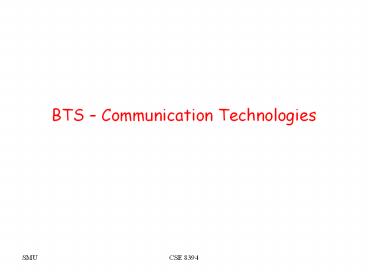BTS - PowerPoint PPT Presentation
Title:
BTS
Description:
Title: BTS Communication Technologies Author: Suku Last modified by: Suku Created Date: 6/24/2004 12:03:50 PM Document presentation format: On-screen Show – PowerPoint PPT presentation
Number of Views:3616
Avg rating:3.0/5.0
Title: BTS
1
BTS Communication Technologies
2
Objectives
- To establish and maintain a unifying exchange and
sharing framework for different types of data - Information exchange essential
- To pre-emergency planning
- Critical first response actions, relief efforts,
and community recovery - Greatly enhance daily operations and cooperation
among agencies in meeting homeland defense
responsibilities - Where the world is going
- Web-based spatial decision support system where
multiple agencies can rapidly share and exchange
their GIS databases and remotely sensed imagery
3
Technology Components
- Command, Control and Communications
- Dispatch
- Force management
- Radio and data communications
- Geographical Information Systems (GIS)
- Global positioning system (GPS)
4
Benefits of GIS
- Deploy response capabilities.
- Locate resources
- Improve planning capabilities
- Develop training scenarios
- Improve accuracy
- Provide timely decision support
- Develop contingency plans.
5
GIS for HS
6
GIS for Emergency Response
- Identifying the location of schools, medical
centers, staging areas, and evacuation routes - Analysis can identify transportation choke
points near bridges or overpasses - Route response vehicles
- Quickly identify critical infrastructures such as
water storage/treatment facilities, communication
networks, electric generation facilities,
refineries, and more
7
Global Positioning System (GPS)
- Worldwide radio-navigation system formed from a
constellation of 24 satellites and their ground
stations - Position identified based on triangulation from 3
satellites - Uses 2 carrier frequencies (L1 and L2)
- Two types PRCodes (C/A and P)
- P could be encrypted ? Y code
8
GPS Applications
- Location - determining a basic position
- Navigation- getting from one location to another
- Tracking - monitoring the movement of people and
things - Mapping - creating maps of the world
- Timing - bringing precise timing to the world
9
Communication Infrastructure
- Requirements
- Reliability
- Security
- Inter-operability
- New initiatives
- Usual suspects
- Satellite communication
- Microwave links
- Infrared channels
- Fiber-optic links
- Wireless
10
Starting from the Bottom
- Sensor Networks
11
What Where When
- What?
- Low cost, low power, multi-functional sensor
nodes - Communicates within short distances
- Enabled by MEMS, wireless, and digital
electronics - Where
- Military, health, environmental
12
Ad hoc Networks vs. SNs
- Number of nodes several orders larger
- Densely deployed
- More prone to failures
- Dynamic topology (frequent changes)
- SNs use broadcasts instead of PP
- Power, CPU, and memory limitations
- No global IDS
13
Applications
- Military/BTS
- c4ISRT, NBC detection etc.
- Environmental
- Forest fire, bio-complexity analysis, flood
detection - Health
- Tele-monitoring, tracking, drug admin.
14
Applications (contd)
- Commercial
- Environmental control of office buildings
- 55 b savings/year, reduction of 35 mmt of carbon
emission - Detection of vehicle thefts
- Inventory control
15
Design Factors
- Fault tolerance
- Scalability
- Cost 1/node
- Cheap BT is 10 times more costly
- Hardware constraints
- Transmission constraints
- Power constraints
16
Security in Sensor Networks
- To provide
- Confidentiality
- Authenticity, integrity
- Timeliness freshness
- With minimum power consumption
- Minimize communication key exchanges
- Private key encryption
17
Trust Model
- Sensor Nodes are not trusted
- Sink node part of the trusted network
- Sink node and the sensor nodes share secret
- Node trusts its own resources
- Clock, memory etc.
18
SPIN Two Protocols
- Secure Network Encryption Protocol (SNEP)
- Provides confidentiality, authentication,
freshness between endpoints - µTESLA - Micro Timed Efficient Stream
Loss-tolerant Authentication - Provides broadcast authentication
19
Encryption Details
- SNEP Private key encryption
- DES-CBC
- Derive subsequent keys from the original shared
key using RC5 - Use counter mechanism for freshness
- µTESLA
- Authenticated broadcast
- Use of public key too expensive, use modified
shared key (delayed disclosure)































